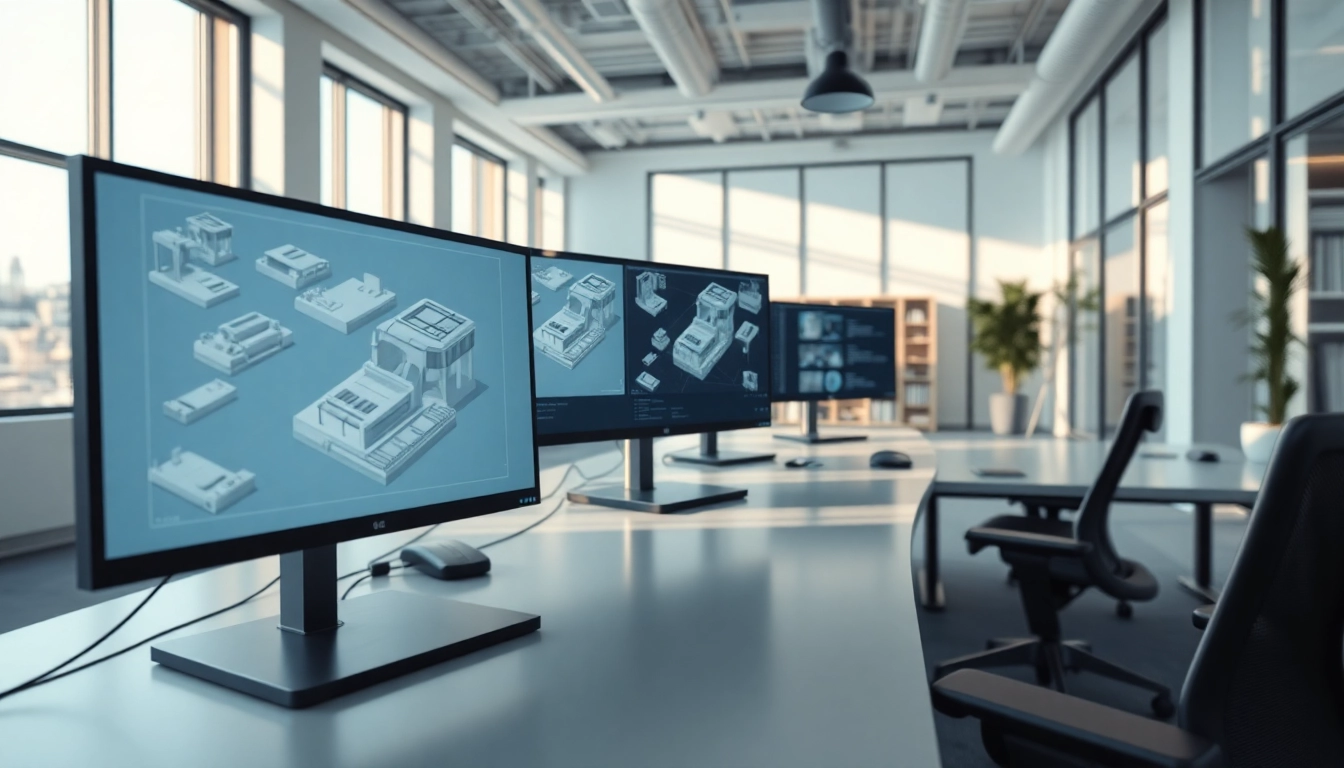Introduction to 3D Model Visualizations
In an increasingly digital landscape, the demand for realistic and interactive representations of products, environments, and ideas is on the rise. 3D Model Visualizations have emerged as a critical tool to meet this demand, allowing users to create immersive experiences that engage and inform audiences. These visualizations are crucial not only for understanding complex concepts but also for facilitating decision-making processes in various fields, from architecture and engineering to marketing and entertainment. As businesses and creators strive to convey their ideas visually, mastering the art of 3D visualization has never been more essential.
What Are 3D Model Visualizations?
3D model visualizations refer to the digital representations of physical objects or environments in three dimensions. Unlike traditional 2D graphics, 3D models allow users to rotate, zoom, and explore a subject from multiple angles. These visualizations are created using specialized software that transforms a conceptual idea into a tangible representation. The end result can be a static image, an animated scene, or an interactive model, depending on the purpose and audience. They are widely used across various sectors, providing users with a deeper understanding of complex concepts and engaging them in ways that flat images cannot.
The Importance of 3D Visualizations in Today’s Market
The importance of 3D model visualizations in today’s market cannot be overstated. In sectors such as architecture and product design, these visualizations provide essential insights that influence the final output. They help stakeholders visualize the end product before any physical work begins, allowing for modifications and adjustments that save time and resources.
Furthermore, in marketing, 3D visualizations serve as powerful tools for storytelling, enhancing brand narratives and facilitating deeper emotional connections with audiences. For example, e-commerce platforms utilize 3D models to allow customers to interact with products, increasing the likelihood of purchases.
Key Technologies Behind 3D Model Visualizations
The technology behind 3D model visualizations is constantly evolving, driven by advancements in computing power and software development. Key technologies include:
- 3D Rendering Software: This software generates 2D images from 3D models by simulating light and materials. Popular rendering engines include V-Ray, Arnold, and KeyShot.
- Real-Time Rendering: Technologies like Unreal Engine and Unity allow for real-time rendering of 3D scenes, which is especially useful in gaming and virtual reality applications.
- Augmented Reality (AR) and Virtual Reality (VR): These technologies enable immersive experiences, allowing users to explore 3D models in an interactive and engaging way.
- 3D Scanning: This process captures physical objects and converts them into 3D digital models, streamlining workflows in industries like manufacturing and preservation.
Tools and Software for 3D Model Visualizations
Overview of Leading 3D Visualization Tools
Several tools and software packages dominate the landscape of 3D model visualizations, catering to various needs and preferences. Some of the most recognized ones include:
- Blender: A free, open-source software that supports the entire 3D pipeline, from modeling to rendering and animation.
- Autodesk 3ds Max: A professional software widely used for modeling, animation, and rendering, particularly in the gaming and film industries.
- SketchUp: Known for its user-friendly interface, SketchUp is popular among architects and designers for creating detailed 3D models.
- Unity: While primarily a game engine, Unity is increasingly being used for architectural visualizations and interactive experiences.
Comparative Analysis: Software Features and Pricing
When choosing the right software for 3D model visualizations, it’s important to consider various features and pricing structures. Here’s a comparative analysis of some popular tools:
| Software | Features | Pricing |
|---|---|---|
| Blender | Open-source, full 3D suite, sculpting, VFX | Free |
| Autodesk 3ds Max | High-end rendering, animation tools, extensive plugin support | $1,620/year |
| SketchUp | Intuitive design tools, 3D Warehouse library | Free for basic; $299/year for Pro version |
| Unity | Real-time rendering, cross-platform capabilities, VR support | Free for personal use; subscription for organizations |
Best Practices for Choosing the Right Software
Choosing the right software for 3D model visualizations requires careful consideration of several factors:
- Assess Your Needs: Determine the complexity of the projects you’ll be working on, as some software is better suited for detailed animations, while others focus on quick modeling.
- Consider User Experience: The learning curve varies between tools. Choose software that aligns with your team’s skill level and experience.
- Evaluate Compatibility: Ensure the software integrates well with other tools and platforms you use in your workflow to enhance efficiency.
- Explore Support and Resources: Look for software that offers robust support, tutorials, and a community to assist users in overcoming challenges.
Applications of 3D Model Visualizations Across Industries
3D Visualizations in Architecture and Design
In architecture and design, 3D model visualizations play a pivotal role. They help architects and clients visualize buildings and landscapes before construction begins. Tools like Autodesk Revit and SketchUp allow architects to create detailed models that showcase not only the aesthetics but also the functionality of spaces. Additionally, walkthrough animations provide stakeholders with immersive previews, enabling them to experience the design in a simulated environment.
Impact of 3D Model Visualizations in Marketing and Advertising
In marketing and advertising, 3D visualizations are becoming increasingly vital. Brands use these models to create compelling advertisements that engage consumers more effectively than traditional media. For instance, interactive 3D models allow potential customers to explore products in detail, leading to more informed purchasing decisions. Companies like IKEA employ AR to help customers visualize furniture in their homes, enhancing the shopping experience and driving sales.
Case Studies: Successful Implementation Examples
Several companies have successfully implemented 3D model visualizations in their processes. For example, Tesla creates lifelike 3D models of their vehicles for online configurations, allowing customers to customize and view their choices in real-time. Similarly, in the real estate sector, platforms like Matterport use 3D visualizations for virtual tours of properties, providing prospective buyers with a more engaging way to view listings without physically visiting the site.
Best Practices for Creating Effective 3D Model Visualizations
Design Principles for High-Quality 3D Visualizations
Creating effective 3D visualizations involves following several design principles:
- Keep it Simple: Aim for clarity by avoiding overly complex models that may confuse viewers.
- Pay Attention to Lighting: Good lighting is crucial for realistic rendering. Use shadows and highlights to enhance depth.
- Select Appropriate Textures: High-quality textures add realism. Ensure they are scaled correctly to match the model dimensions.
- Incorporate Context: Placing models in relevant environments helps viewers understand their use or function.
Common Mistakes to Avoid in 3D Rendering
While crafting 3D visualizations, avoid these common pitfalls:
- Ignoring the Audience: Create models tailored to the target audience’s understanding and expectations to foster engagement.
- Neglecting Performance: High-resolution textures and detailed models can slow down rendering times. Optimize your models for better performance.
- Forgetting Proportions: Ensure that your models are true to scale; unrealistic proportions can detract from the visualization’s credibility.
Tips for Enhancing User Engagement through Visuals
To enhance user engagement, consider these strategies:
- Utilize Interactivity: Offer interactive elements that allow users to manipulate the model for a hands-on experience.
- Storytelling: Use visuals as a storytelling tool to convey a narrative that draws viewers in.
- Mobile Optimization: Ensure that visualizations perform well on mobile devices as many users access content via smartphones.
The Future of 3D Model Visualizations
Trends Shaping the Future of 3D Visualization Technology
The future of 3D model visualizations is bright, influenced by emerging trends such as:
- Artificial Intelligence (AI): AI is set to revolutionize how 3D models are created and rendered, offering tools that learn from user interactions and improve accuracy and efficiency.
- Cloud-Based Solutions: Increased adoption of cloud technology is enabling collaborative workflows and making powerful visualization tools accessible from anywhere.
- Integration with IoT: The Internet of Things (IoT) will allow for real-time data integration with 3D visualizations, enhancing interactivity.
Potential Challenges and Solutions
While the prospects are exciting, challenges remain. Some common challenges include:
- Complexity of Software: Many users face a steep learning curve. To mitigate this, developers should provide comprehensive tutorials and support networks.
- Hardware Limitations: Not everyone has access to high-end computing resources. Cloud-based rendering solutions can help scale resources according to needs.
Conclusion: Embracing Change in 3D Model Visualizations
3D model visualizations are not just a trend; they represent a crucial evolution in how we communicate ideas and concepts. As technology advances, it is essential to stay updated on best practices and emerging tools to create engaging and effective visualizations. By embracing change and harnessing the power of 3D, creators and businesses can elevate their offerings, connect more profoundly with their audiences, and contribute to a more visually dynamic world.























+ There are no comments
Add yours